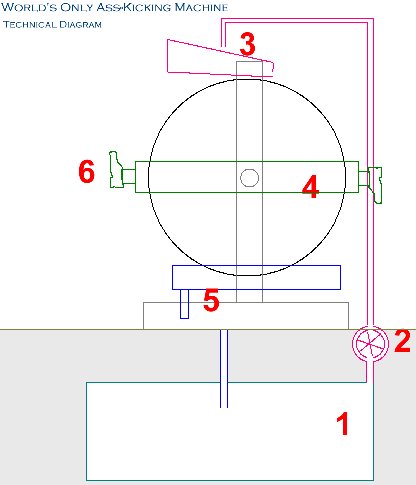 The World's Only Ass-Kicking Machine is simple yet elegant in design. We will initially detail the method of operation, and then discuss the design in more detail.
The World's Only Ass-Kicking Machine is simple yet elegant in design. We will initially detail the method of operation, and then discuss the design in more detail. The World's Only Ass-Kicking Machine is simple yet elegant in design. We will initially detail the method of operation, and then discuss the design in more detail.
The World's Only Ass-Kicking Machine is simple yet elegant in design. We will initially detail the method of operation, and then discuss the design in more detail.
As we mentioned, this is an "overshot-type" wheel, of a type common in America during the 19th century and used to mill grain, saw wood, power looms, and kick asses in the early Industrial Revolution. This provides a fine example of a working overshot wheel which has not been consigned to a museum but which is still performing a useful task.
One possible improvement to the design might be the addition of a second radial arm to the wheel arranged perpendicular to the existing single arm. This would transform the ass-kicker into a "4-stroke" model, but the benefits of doing so might be slim. The additional moving parts would result in double the footwear cost, failure to accurately match the weight of the arm and the kickers might result in out-of-balance operation, and most seriously, the additional weight could result in premature bearing failure, resulting in catastrophic loss of the ass-kicker and crew. Additionally, it might prove impractical to line up subjects quickly enough to keep up with an ass-kicker which could, conceivably operate at over 200 asses per minute. We suggest detailed engineering analysis before you attempt such a design modifications.
Where a source of water is unavailable, a hub and sprocket could be fitted to one side of the wheel and a chain-drive attachment put in place. Thus, the wheel could be driven by any convenient source of power such as a gasoline or diesel stationary engine, a tractor power-take-off (PTO) unit, or a large electric motor. Care should be taken in matching the output torque of the external source to the size of the ass being kicked, lest the ass be kicked into the next county.
We have been advised that a non-recycling ass-kicker similar to this in design may exist in North Carolina, a design lacking a pump and holding tank. The operation of such a device would seem to be based around a source of water such as a garden hose and a collection mechanism such as a gutter or ditch. In the interest of conservation and water resource management, we cannot recommend such as design for anything but laboratory or experimental use. One of the obligations of an operator of an ass-kicker such as this is to use it responsibly, and preservation of natural resources should be a given.
What are the design limits?
We conducted considerable research into what the design limits of this type of design might be. We realized that the limitation of the design as built centers not around the design itself but the delivery mechanism for the workload. As mentioned above, it would seem to be impractical to deliver more than 150 to 200 asses per minute to the action area of the ass-kicker without encountering congestion or the dreaded double-kicking. We envision a modern, high-speed conveyor system of the type used in air terminals or cargo handling facilities. With such a mechanism stationed in close promixity to the action area of the ass-kicker, and with replacement of the simple-but-durable wood and mild steel components with modern alloy and carbon-fiber materials, we calculated that this design could be stable and efficient at speeds of up to 4800 asses per minute, assuming a 4-kicker radial arm design, dynamically balanced. This would require a wheel speed of 1200 rpm, speed above which the noise from the airflow around the laces and sole would be intolerable for the operator.
At this throughput, it could be possible to kick the ass of everyone in the United States of America in 34 days, 17 hours, 40 minutes.
We are applying for research funding to develop a testbed and evaluation methodology.